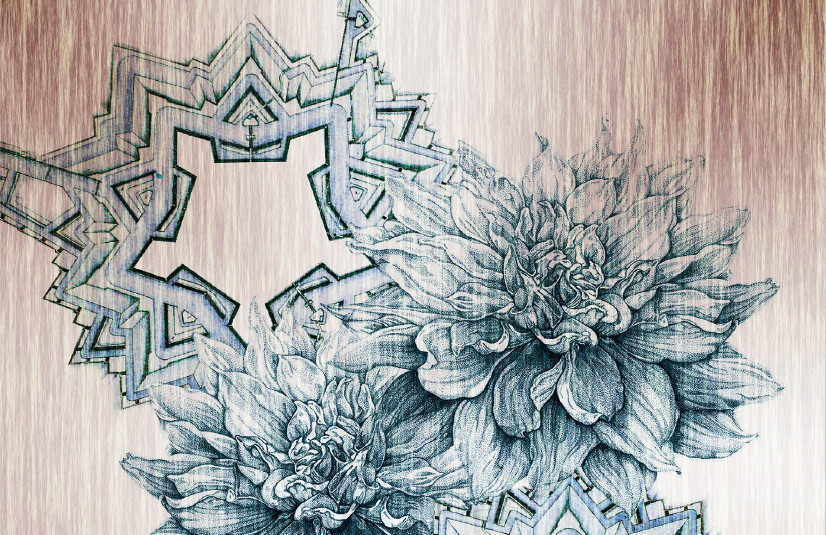(For English, Please Scroll Down)
⤞女頭目的未來學 #4⤝
Beatrice Glow –〈花語碉堡〉
時間:2019.10.19 – 11.10,每週二到日,1-7pm
地點:台北當代藝術中心 TCAC (台北市大同區保安街49巷11號1樓,近捷運大橋頭站)
開幕:2019.10.19 6pm
台北當代藝術中心(TCAC)推出2019全新帶狀節目《女頭目的未來學》,第四回合為美國藝術家 Beatrice Glow 呈現〈花語碉堡〉。展覽呈現 Glow 由 2015 年開始的計畫《洛倫哈頓: 雙島記 》的部分研究,該計畫以錄像裝置與數位印刷的絲絹呈現美國紐約曼哈頓以及印尼班達群島的洛倫島(Rhun)由一紙條約而交纏在一起的歷史。
英國與荷蘭持續數十年的香料戰爭,在雙方於 1667 年簽訂布雷達條約劃下句點。荷蘭將被美國原住民稱為 Mannahatta (今曼哈頓)的所有權讓予英國,得到英國佔領的印尼班達群島的洛倫島。〈花語碉堡〉回溯這段歷史,在這兩個曾發生對當地原住民大屠殺歷史的島上,座落著相似的星形碉堡。這些遺跡不僅作為歐洲霸權以及壓榨殖民地的證據,同時也串連起兩個相距遙遠的土地上的人民與文化。Glow 拜訪洛倫島時,發現遺跡附近生長著野花,而當地居民會帶著花朵至此憑弔大屠殺的過去。
〈花語碉堡〉回溯歷史的創傷,並置性質對立卻關係交纏花朵與碉堡的圖像,是對剝削,重生,反抗反覆循環過程的隱喻。如藝術家所言:「在毒物學中,一株藥用植物根據劑量的不同,可以治療也可傷人。」花朵往往作為女性的象徵,不單是因為美麗,也是貶低其女性作為主體的能動性。但事實美麗作為武器也是一種生存方式,同時也是女性力量與韌性的展現。
⤞關於藝術家⤝
Beatrice Glow 創作媒材多元,使用行為藝術、繪畫、體驗性科技合作、氣味藝術、雕塑性裝置與影像游移於主流敘事之間。她是 2019-2020 Lower Manhattan Cultural Council Workspace 工作室藝術家 , 2018-19 Smithsonian 藝術家研究學者和 2018-19 Smack Mellon 工作室計劃藝術家。也是 2017-18 年美國藝術孵化器(American Arts Incubator)的 ZERO1 藝術家,該計畫注重提昇原住民與和非裔厄瓜多爾的能見度。她在紐約大學(New York University)的 2016-17 年度亞太地區╱美國研究所主持了虛擬和增強現實項目〈尋路項目〉和〈Mannahatta VR〉,以及與原住民環境管理結盟的公共設施〈Lenapeway〉。她獲得了 2013 年Franklin Furnace 基金的〈浮動圖書館〉補助,這是哈德遜河 Lilac 博物館輪船的快閃式公共空間。作為 2008-9 年度 Fulbright 學者,她發展有關亞洲移民至秘魯的移民博物館計畫以及出版三語系的藝術家書籍。
舉行過的個展包括 Beatrice Glow: Spice Roots/Routes(紐約大學藝廊,2017), Lenapeway(紐約大學藝廊, 2016), Aromérica Parfumeur(智利國家美術館, Santiago, Concepción, 2016), Rhunhattan Tearoom(紐約 Wave Hill, 2015)。群展包括 2017 年檀香山雙年展,紐約公園大道軍械庫和印度尼西亞國家美術館。同時是杜克大學出版社的《文化政治雜誌》報導藝術家。作為半球學會理事會成員,她與夥伴共同創立了演繹亞洲╱美洲:融合運動工作組。她擁有紐約大學藝術學士學位,同時擔任視覺藝術學院 MFA 藝術教師以及紐約-紐華克公共歷史計畫的策略經理。
⤞女頭目的未來學:母系‧生產‧生態⤝
TCAC推出2019全新帶狀節目《女頭目的未來學》,以系列展覽與公眾參與活動帶領觀眾想像:母系的生產將如何領導與批判科技與資本主義治理的社會。我們希望在超越邊界的前提下討論唐納‧哈洛威談的女性「類同」。以此為背景,《女頭目的未來學》重新檢視第四波女性主義中科技對女性賦權的樂觀,以及馬克思女性主義與生態女性主義的方法學。
參展藝術家多在網路時代成長,其中有些擁有身為離散族群的生命軌跡,他們享受60-70年代的女性主義運動成果,但仍弔詭地在生命歷程中面對不同程度的性別暴力。跨文化的背景使他們將性別權力的討論延伸到不同的空間,包括情動、個人歷史、去殖民、環境生態。參展藝術家以個人敘事回應本展的潛在台詞:「如果不成為母親,女性藝術家如何面對女性認同相關的藝術生產?」母系回應父權暴力的方式,絕不是生理、同質、抽象、排除他者的。我們希望女頭目透過各種「跨」,來化身為溝通者與預言者,連結男子、女人、酷兒、移民、非人類。或者說,女頭目的預言,是一個包容跨物種的未來生態系統。
《女頭目的未來學》由徐詩雨與李雨潔共同策展。
#FemaleAvatarsFuturistStatement #TCAC #TaipeiContemporaryArtCenter #FlowersandForts
《女頭目的未來學》獲國家文化藝術基金會與台北市文化局支持。
⤞Female Avatars’ Futurist Statement #4⤝
Beatrice Glow– Flowers and Forts
Time: 2019.10.19 – 11.10, Tue. – Sun., 1-7pm
Venue: Taipei Contemporary Art Center (1 Fl, No.11, Lane 49, Baoan Street, Datong District, 10346 Taipei)
Opening: 2019.10.19 6pm
The fourth exhibition of the Female Avatars’ Futurist Statement series, Flowers and Forts, is presented by artist Beatrice Glow. The exhibition consists of video works and prints on silk, presenting parts of Glow’s long-term research project Rhunhattan: A Tale of Two Islands since 2015. The project focuses on the history that connects two islands, Mannahatta/Manhattan and Rhun of the Banda Islands, Indonesia.
Lasting over decades, the Spice War between the Dutch and the English came to an end with the Treaty of Breda in 1667. The two parties agreed to exchange their colonial territories of Mannahatta/Manhattan and Rhun of the Banda Islands, Indonesia. On each island, there are identically shaped star forts (trace italienne) that each witnessed the massacre of native peoples. The fortifications are architectural markers of European domination and extraction that link together lands, people, and cultures across the globe; they signify shared histories and cultural heritages. When Glow visited Fort Nassau in Banda Neira, Maluku, Indonesia, she found wild flowers growing in forts. Upon inquiring, she learned of local practices of bringing flowers to commemorate difficult histories.
Flowers and Forts traces traumatic memories in history. By juxtaposing the images of flower and forts, two seemingly disparate subjects, the works allude to cycles of exploitation, regeneration and resilience. As the artists mentions: “In the field of toxicology, a medicinal plant administered at different dosages can either heal or kill.” Flowers are often analogies for women not only to praise beauty, but also to minimize presence and agency. However, a beautiful plant could be weaponized as a means for survival, an embodiment of feminine power and resilience.
⤞The Artist⤝
Beatrice Glow is an interdisciplinary artist leveraging participatory performance, painting, experiential technology collaborations, olfactory art, sculptural installations and video to shift dominant narratives. She is a 2019-2020 Lower Manhattan Cultural Council Workspace Artist, 2018-19 Smithsonian Artist Research Fellow and 2018-19 Smack Mellon Studio Program Artist. She was a 2017-18 ZERO1 American Arts Incubator artist amplifying Indigenous and Afro-Ecuadorian voices. Her 2016-17 Asian/Pacific/American Institute at New York University residency led to virtual and augmented reality projects “The Wayfinding Project” and “Mannahatta VR,” and public installation “Lenapeway” in allyship with Indigenous environmental stewardship. She received a 2013 Franklin Furnace Fund grant for “Floating Library”—a pop-up public space aboard the Hudson River’s Lilac Museum Steamship. As a 2008-9 Fulbright Scholar, she developed a migratory museum and trilingual artist book on Asian migration to Peru.
Notable activities include solo exhibitions “Spice Roots/Routes” (2017) at NYU Institute of Fine Arts, “Aromérica Parfumeur” (2016) at Museo Nacional de Bellas Artes de Chile and “Rhunhattan Tearoom” (2015) at Wave Hill; group shows at Honolulu Biennial 2017, Park Avenue Armory and Galeri Nasional Indonesia; and a Duke University Press’ Cultural Politics Journal artist feature. As a Hemispheric Institute Council Member, she co-founded the Performing Asian/Americas: Converging Movements workgroup. She holds a BFA in Studio Art from New York University and is a School of Visual Arts MFA Art Practice faculty member and strategy manager for the New York – Newark Public History Project.
⤞Female Avatars’ Futurist Statement: Matrilineage, Production, Ecosystem⤝
In 2019 TCAC is launching a new program called Female Avatars’ Futurist Statement. Through this series of exhibitions and public workshops, we hope to unite leaders and art workers who share a vision of matrilineal production. Reflecting on the dominance of information technology and capitalism, which hinder genuine equality and diversity in our society, we look for new directions for feminist “affinities” across borders. Female Avatars’ Futurist Statement cautiously examines the techno-optimism embedded in the fourth-wave feminist movement, and perspectives inspired by Marxist Feminism and Ecofeminism.
Participating artists grew up in the information age, and many of them experienced diaspora. They enjoyed the achievement of feminist movements in the 1960s and 1970s, which, however, do not guarantee a world without gender violence. Their cross-cultural backgrounds enable them to extend the discussion about gender power to various aspects regarding affect, personal histories, decoloniality, and ecosystem. Their individual narratives respond to the underlying note of the exhibition: “How does a [woman] artist cope with [her] practice without being a mother?” Art of the so-called “maternal lineage” does not refer to sex- and gender-specific products, nor is it homogenous, exclusive, or instrumentalized. The future avatars have to be communicators and prophets who can form an alliance with men, women, queer people, immigrants, and non-humans. Thus, this futurist statement delineates an ecosystem that accommodates all species.
Female Avatars’ Futurist Statement is curated by Shih-yu Hsu and Yu-Chieh Li.
#FemaleAvatarsFuturistStatement #TCAC #TaipeiContemporaryArtCenter #FlowersandForts
Female Avatars’ Futurist Statement is supported by the National Culture and Arts Foundation and The Department of Cultural Affairs, Taipei City Government.

